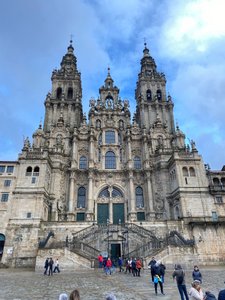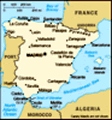Advertisement
Published: December 15th 2022

 Catedral Basilica de Santiago de Compostela
Catedral Basilica de Santiago de Compostela
Catedral Basilica de Santiago de Compostela - Santiago de Compostela Cathedral. Initially built in 1075-1211. The Baroque west façade facing the Plaza de Obradorio was added in 1740.
"... the Cathedral, the most important monument of the early-Romanesque style in Spain. The building of the present church began in 1078 or 1082 under Bishop Diego Primero Peldez, was zealously furthered by the first archbishop, Diego Segundo Gelmírez (1100-1130), and went on during the whole of the 12th century. The consecration took place in 1211. ... The W. Façade, known as El Obradoiro, was erected by Fernando Casus y Novoa in 1738 and is in the most extravagant baroque style. On the ramps of the wide flight of steps in front of it, arranged in four sections, some Romanesque sculptures have been placed. The huge gable is surmounted by a statue of St. James and flanked by two towers, each 230 ft. high and resting on Romanesque foundations".--Baedeker 1913.
Santiago de Compostela (Old Town) UNESCO World Heritage site.
IMG_8595We were now in the Spanish province of Glaicia, which has many historic and linguistic ties to Portugal. Motoring north along Autopista AP-9, we passed Vigo at 3:00 p.m. Catching a glimpse of Vigo was interesting. It has a large Atlantic-facing port and is Spain's most important fishing port. Cruise ships call at Vigo for shore excursions to Santiago de Compostela. The city and port are situated on the Ria de Vigo estuary, which we crossed on the Ponte de Rande highway bridge. A number of raft-looking objects were floating in the estuary. These were
Bateas, used for Galician mussel farming. Between Vigo and Pontevedra, the coach made a stop at Área de Servicio San Simón for an afternoon break.
Arriving in Santiago de Compostela, the coach boldly drove right up into the historic district and stopped in front of the Parador, hotel. The Parador, or
Hostal dos Reis Católicos, is a historic building itself, built in 1501-1511. It was planned as a refuge for pilgrims upon completing their journey along the Camino de Santiago. The building was renovated as a modern hotel in 1954 and is part of Spain's network of Paradores. A more marvelous hotel would be difficult

 Hostal dos Reis Catolicos
Hostal dos Reis Catolicos
Parador de Santiago de Compostela - Hostal dos Reis Catolicos. Commissioned by Ferdinand and Isabella. Adaptive reuse as a hotel in 1954. Praza do Obradoiro 1.
"To the N. is the Hospital Real, founded in 1489 by the 'Catholic Kings' and erected in 1501-10 by Enrique de Egas. The entrance and the two S. courts (in the Renaissance style) demand attention".--Baedeker 1913.
Santiago de Compostela (Old Town) UNESCO World Heritage site.
IMG_8695to imagine. One is staying in a World Heritage site building to begin with, retaining much of its original floorplan. Thus, there are long, uneven, corridors to negotiate. The rooms are commodious, with heavy wooden beds, chests of drawers and closets alongside up to date bathrooms. A heavy metal room key is used, no keycards here! It is right next door to the Cathedral of Santiago de Compostela.
After settling into our rooms, the group met with our local guide on the Praza do Obradorio at 6:30 p.m. The square has the cathedral to the west and the Parador to the north. People were amassing all over the plaza to have their photo taken with the cathedral in the background. Many were individual or group pilgrims and were filled with excitement about completing their journey. (One must walk at least 100 km or cycle 200 km to be considered to have made the pilgrimage.) We were to visit the cathedral tomorrow. Right now, the guide wanted to orient us to the historic district and identify restaurants where we could find dinner.
A walk down Calle del Franco revealed all manner of places to dine. They all had window

 Colegio de San Jerónimo
Colegio de San Jerónimo
Colegio de San Jerónimo - Colexio de San Xerome. The building current houses the Rectorate of the University of Santiago de Compostela and a residence hall. Plaza de Obradorio.
"To the S. is the Colegio de San Jerónimo, now a normal school, with a fine portal of the 15-16th centuries".--Baedeker 1913.
Santiago de Compostela (Old Town) UNESCO World Heritage site.
IMG_8684displays of interesting foods. Roasted barnacles and octopus were two of the more unusual items. However, the customary dinner hour in Spain begins at 8:00 p.m. and many restaurants do not open before then. Pestiscos do Cardeal was one that did. Pestiscos do Cardeal is a tapas restaurant in old town Santiago de Compostela. It conveniently opens for dinner at 7:00 p.m. Thus, most of the group queued up outside waiting for it to open. At 7:00 p.m., the doors opened. The illustrated menu was in Spanish and full of temping items. One of the waiters could interpret some of the selections, but even my limited ability to read and order in Spanish was a definite plus. We ordered bread (Plato de Pan), Flauta Lomo con Queso, Flauta Bacon-Queso, Tapa de Chorizo Ibérico, Tapa de Jamón Ibérico and Huevos a la Cazuela. This order was delicious! But, it turned out to be a feast and would have been enough for four persons. Still, it was quite reasonably priced at about 33 Euro for two.
I'm still learning the way of Tapas. Each tapas item portion here was sizable enough for sharing. (We had tapas in Barcelona where a selection

 Roasted Barnacles
Roasted Barnacles
Roasted Barnacles on a scallop shell. Roasted barnacles are popular in Portugal and Galicia.
IMG_8686was an individual serving. Perhaps the Catalonian and Galician ways with tapas differ.) I think three selections here would be sufficient for two people. The
Huevos a la Cazuela was the most interesting selection. It was what I would describe as a skillet dish or a casserole with a baked egg on top. Very shareable or nearly a meal in itself!
My culinary journey in Santiago de Compostela led me to differentiate the
Bocadilla vs. the
Flauta. In Spain, both
Bocadillas and
Flautas are sandwiches made with a thin baguette with
queso (cheese), olive oil and either
Jamón Ibérico,
Jamón Serrano or chorizo. Jamón is very big in Spain and I am on board with that! A Bocadillo uses a thin baguette about 6-8 inches long while a Flauta is simply a smaller sandwich, on a shorter baguette. (A
Flauta sandwich in Spain is very different from
Flautas in Mexican cuisine.)
Arriving at 7:00 p.m.there was a lot of seating in the restaurant. By the time we left, the restaurant was quite full.
<br style="color: font-size:

 Octopus
Octopus
IMG_8690p114px;" />
Advertisement
Tot: 0.388s; Tpl: 0.014s; cc: 22; qc: 93; dbt: 0.2019s; 1; m:domysql w:travelblog (10.17.0.13); sld: 1;
; mem: 1.3mb


















D MJ Binkley
Dave and Merry Jo Binkley
Huevos
I love food photos! ... This looks perfect.